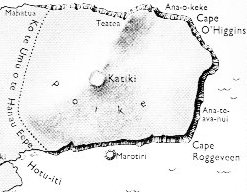10. Although Tama ('Son') could mark where a new year is beginning, the kuhane continued her journey towards east a bit longer by naming 2 further stations: The dream soul went on and came to One Tea. She named the place 'One Tea A Hau Maka O Hiva'. She went on and reached Hanga Takaure. She named the place 'Hanga Takaure A Hau Maka O Hiva'. Hanga Takaure is located where the great Poike peninsula is beginning to rise high above the sea level:
A thick line on the map indicates the steep and high coast around the peninsula. This high ground - in the Maori dialect poike means 'place aloft' - seems in myth to be correlated with the time in the month when Moon stands high in the sky. On Hawaii the 15th night of the Moon was named Hoku (Hotu):
And according to Manuscript E the highest point on Poike is Pua Katiki: The dream soul moved upward and came to (the elevation) of Poike. She named the place 'Poike A Hau Maka O Hiva'. The dream soul continued to ascend and came to the top of the mountain, to Pua Katiki. She named the place 'Pua Katiki A Hau Maka O Hiva'. On Hawaii the 17th night was Kulu (Turu) which name means to descend (or to come down like a drop). ... Number 17, Kulu (Turu), should be the day when 'the rising fish' turns around into a 'descending fish'. Number 17 also represents, we know, the first item in a new sequence of events. The first sequence of glyphs - in at least certain glyph lines - are ending with number 16. Next comes 'the first night of the rising tree' (Laau-ku-kahi, Rakau-tu-tahi), and it was also said to be the first night in the month when the tide was rising. Number 18 could allude to 18 * 10 = 180 days or half a year, when Sun on his path has reached his highest point (high summer). He must then turn around and - according to myth - abruptly dive down into the 'sea', which seems to be a form of speach for the arrival of the rainy season comparable to the expression 'a high tide' (Laau-ku-kahi is blackmarked by me), i.e. with the arrival of the 2nd half of the month - and therefore probably also with the 2nd (Moon) half of the year. The 'Bay of Flies', which is Barthel's translation of Hanga Takaure, seems to indicate both a location of rest (probably signifying a solstice) and a station where Sun has taken on the form of an insect (a 'horse fly') - i.e. a 'dry old one':
Sun is dead, but his spirit (manu rere) lives on. And we know the probable next stage of the story, he will regenerate himself by 'spitting in the hand' of Moon in form of a maiden. |
